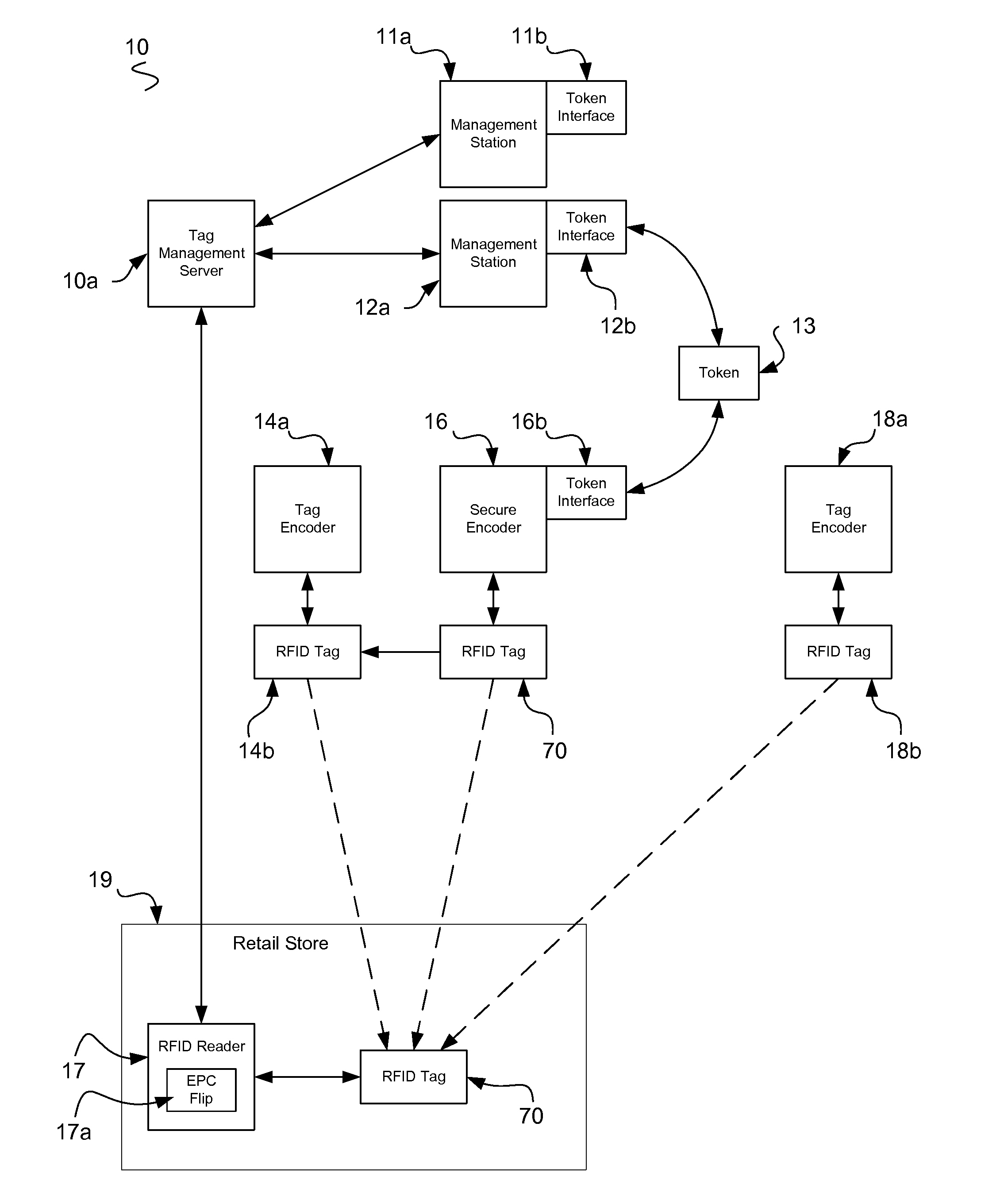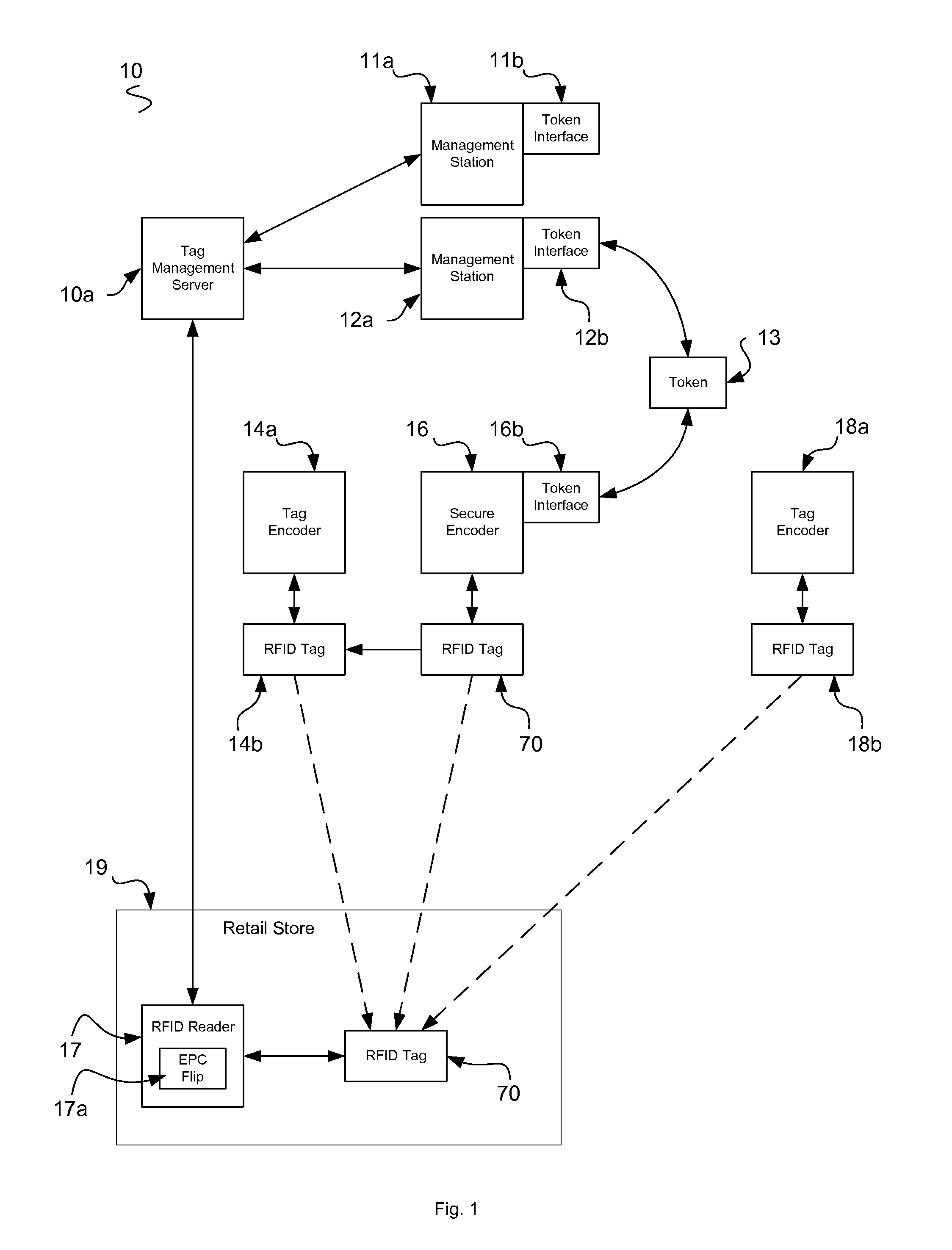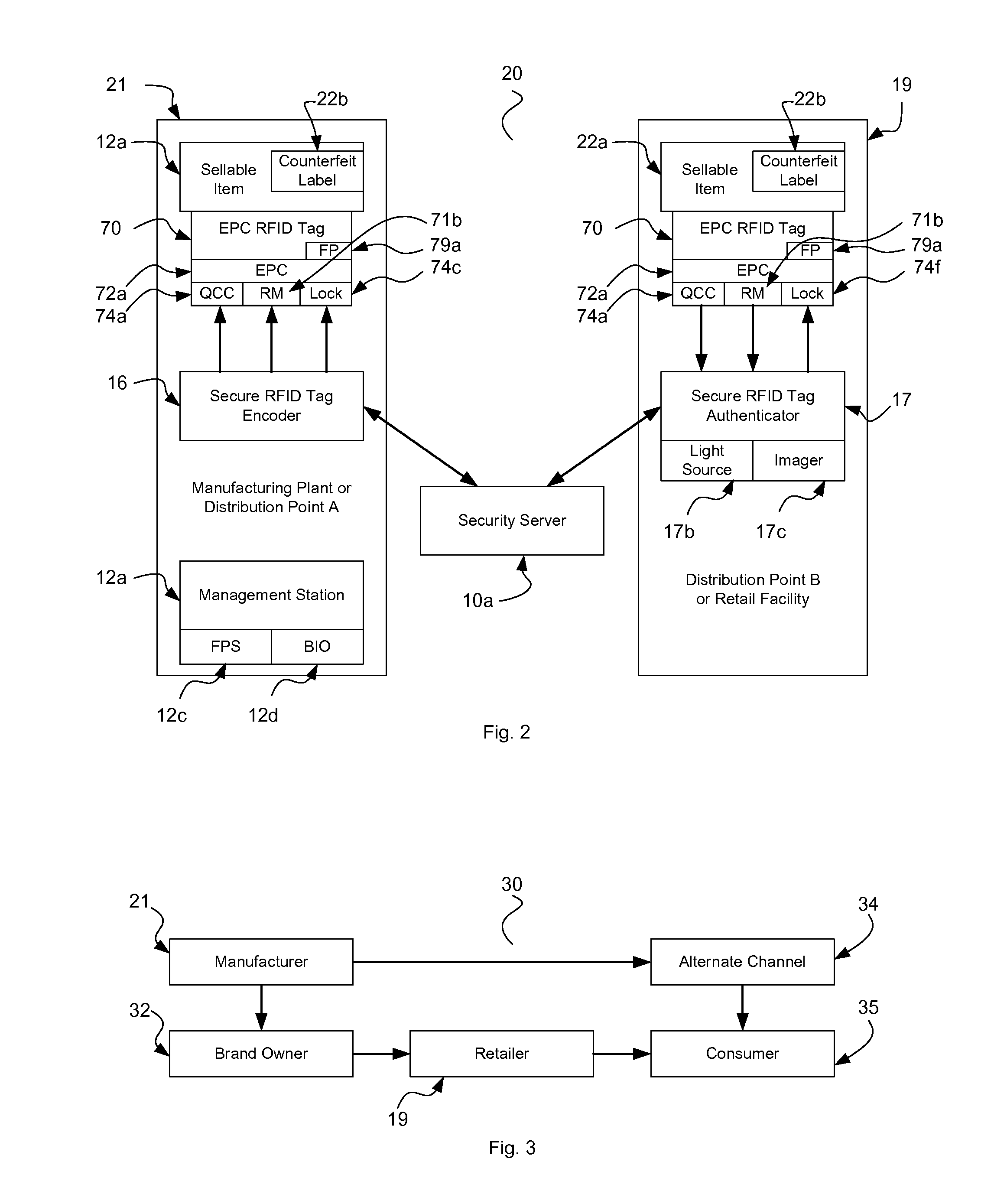Many commercial brand owners incur enormous losses to counterfeiters.
The production and distribution of counterfeit products is difficult to measure, but official estimates are from 5 to 7% of the entire world's trade.
In many cases foreign workers and managers of production have little or no loyalty to the brand owner.
With the means of legitimate production in their hands, there has been little to prevent them from distributing those products in a manner to reap higher profits.
Excess product is produced and distributed without the use of anti-counterfeiting measures making it impossible to distinguish a ‘perfect’ counterfeit from the authentic product.
However, the Gen2 RFID tag lacks a crypto engine because it was deemed to require too many transistors and too much power to operate as a passive RFID tag.
Lacking this, brand owners have been presented with an unsatisfactory means of preventing duplication of Gen2 tags that would at face value been an unambiguous indication of the true authenticity of a product that appears to be one of theirs.
Staake claims that counterfeit products are responsible for 192,000 deaths in China in 2001 because of fake drugs, fake baby formula has caused infants to develop rashes and seizures, 1 Million counterfeit birth control pills have caused unwanted pregnancies, Indian
hospital patients die from counterfeit glycerin, counterfeit bolts are blamed for a Norwegian air plane
crash that killed 55 passengers, malfunctioning counterfeit parts were discovered in $7 million worth of open heart
surgery pumps, 7 children died when their
bus crashed because of fake
brake pads, counterfeit
shampoo was found to contain harmful
bacteria, risk of explosion is high in counterfeit batteries.
His assumption was that the queries of secure RFID tags were often made in conditions where there was risk of
eavesdropping by untrustworthy observers.
They are poor authenticators, though, as they possess no explicit
authentication functionality.
Thus, EPC tags are vulnerable to counterfeiting or other types of
cloning attacks.An attacker can learn an EPC tag's essential data, its EPC, simply by scanning it or by gaining access to an appropriate tag
database.
For awhile, the
chip manufacturers only offered Read-Only Memory (ROM) in the TID
bank, making it infeasible for counterfeiters to copy both the EPC and TID of a legitimate RFID tag.
The repository accumulates data over relatively long periods of time during which the data may not be immediately useful to any particular application or device.
Generally speaking, a flow of information for a number of objects may be too great for the repository to be practically useful in real-time, particularly given potential network delays.
The short falls of this method of determining the authenticity of products is very network and
server-intensive, and requires an omniscient overseer role to be performed by a global
data processing entity.
As difficult and impractical as all this may be to implement, it is even more unlikely that retailers will opt to open an EPCIS portal to such an overseer if they believe that it is possible that they would be caught selling counterfeit goods—even if it is not directly their own fault.
Although barcodes are scanned and RFID transponders are encoded, the inventors are stuck with having to VOID products that have an RFID
transponder that will not
encode properly, resulting in waste and disposal of goods.
This patent also fails to address the anti-counterfeiting measures that are needed to assure that valid RFID transponders are not duplicated, as would be the goal of modern day pirates.
Similarly Curt Carrender's U.S. Pat. No. 7,055,750 has the same limitations, plus any RFID
transponder failures require at a minimum some amount to
rework.
This patent also fails to address the anti-counterfeiting measures that are needed to assure that valid RFID transponders are not illegally duplicated.
Printing hardware, consumable materials such as ribbons, ink, and paper all unnecessarily add to the cost, weight, size of equipment and the resulting transponders.
These patents as with other printer /
encoder patents neither anticipate the need for nor solve transponder or item counterfeiting problems.
The use of these unsecured devices threatens to compound global counterfeiting problems by encoding transponders in a manner that leaves tags as easy targets for illegal
copying and
cloning on a massive scale.
With this prior art, the identification tag cannot be assured to represent an authentic supply of
consumables.
Therefore prior art for using
authentication of items prior to that date is unlikely to include the scope and depth of the FIPS standard.
Furthermore since the prior art listed below is generally for protection of consumable inks and media for printing, the prior art fails to anticipate the need for anything more than a minimal level of security and certainly not to a degree that would require military-grade cryptographic
key management and tamper detection countermeasures for the cryptographic module.
Counterfeit bar codes have long been a problem when used on tickets for events and ski resorts.
That same solution cannot be practically used because there is no focal
point of entry, duplicates would have to be checked for throughout the world, in
flea markets and pawn shops everywhere.
This is approach is heavily networked, requires overlord authorizations with multiple retail outlets, feet on the street, and is very expensive and impractical.
So, despite recent advances in RFID technology, the state-of-the-art does not fully address the needs of authenticating
wireless sensors that are already in broad public use.
This is the risk that is presented by the using the Electronic Product Code (EPC) with the unprotected Unique Item Identifier (UII) in retail supply chains or beyond the
public space of the retail sales floor.
Stapleton's article fails to address the needs of the retailer in a retail setting to hide the EPC code of the tag in an encrypted form, while still allowing the retailer to convert the encrypted identity back to its original EPC code without using a
database to map the conversion from a public identity to a store-internal value.
Using such a
database relies on network timing, many times an open internet connection with non-deterministic network delays.
The prior art does not fully address the needs of the retailer in a retail setting to hide the EPC code of the tag in an encrypted form, while still allowing the retailer to convert the encrypted identity back to its original EPC code when desired (i.e. when a
consumer returns a product).
The prior art claims a novel way to ‘kill’ an RFID tag, however; the prior art does not address the needs of the retailer in a retail setting to hide the EPC code of the RFID tag.
However, the invention does not fully address the needs of the retailer in a retail setting to hide the EPC code of the tag in an encrypted form, while still allowing the retailer to convert the encrypted identity back to its original EPC code when desired (i.e. when a
consumer returns a product).
However, the invention does not fully address the needs of the retailer in a retail setting to hide the EPC code of the tag in an encrypted form while still allowing the retailer to quickly revert the encrypted tag ID back to the original EPC code.
However, the invention does not address the needs of a retailer in a retail setting to hide the EPC code of the tag in an encrypted form while still being able to read an RFID tag at a significant distance.
If a retailer was only able to read an RFID tag at short range, they lose the inherent benefit of RFID to take inventory quickly and easily.
The novel ideas of the prior art do not address the need of the retailer in a retail setting to hide the EPC code of the tag in an encrypted form, while still allowing the retailer to convert the encrypted identity back to its original EPC code when desired.
Like most other prior art in this area, the inventors have discovered a novel way of disabling an RFID tag, but have not addressed both the needs of the retailer and the
consumer by hiding the publicly decodable EPC information while not disabling the RFID tag from being read.
The prior proposes a novel way to disable a tag, but does so permanently such that the RFID tag cannot be reactivated with preexisting data intact.
For example, no longer is an RFID tag able to be read for product returns.
However, the invention does not fully address the needs of the retailer in a retail setting to hide the EPC code of the tag in an encrypted form, while still allowing the retailer to convert the encrypted identity back to its original EPC code when desired (i.e. when a consumer returns a product).
However, the invention does not address the needs of a retailer to hide the publicly decodable EPC identifier while the packages are stocked in the retail store.
ivacy. Even if the alteration is reversible, the prior art fails to address the privacy needs of a retailer to hide the publicly decodable EPC identifier while the RFID tag and associated product are stocked by the re
The novel idea would not be able to efficiently
handle the
throughput of encrypting and decrypting consumer
package goods at the item level.
Though some of these mechanical methods are reversible, they don't protect the retailer from competitor reads.
Prior art that disclose
encryption methods for hiding an RFID tag's unique identity generally do not recognize the
throughput and
scalability requirements of tagging consumer
package goods at the item level.
In conclusion, none of the prior art introduces novel ideas to efficiently and cost effectively encrypt an RFID tag's unique
numbering to protect the retailer from competitor reads and to protect the consumers' privacy.
 Login to View More
Login to View More  Login to View More
Login to View More 


